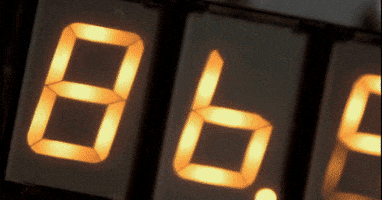ENTIRE POST CURRENTLY IN ROUGH DRAFT STATUS AND INCOMPLETE - CHECK BACK SOON FOR DETAILS ON HOW TO PREPARE ALL SOLUTIONS ETC
LAST UPDATE 2013/10/30 12:52
Hello All,
So as promised, here is the follow up to the “MacGyver Guide to Extracts” post. In the previous post, I covered a few methods that you could perform using things that you could probably find laying around the house, or purchase at the grocery store. This post will cover more advanced methods that will likely require purchases and more precise procedures. However, it will not require sophisticated laboratory equipment and can still be done at home. Accordingly, this an intermediate guide, and not yet the “Walter White Guide to Extracts” which I will post if and when I get around to performing and photo-documenting the full, laborious and time consuming process. Without laboratory equipment such as vacuum pumps, there will be more degradation of the capsaicinoid compounds, but if done properly, you should still be able to take down a grizzly bear with the final product.
This post’s target audience is the scientifically-curious general public, not trained chemists. It will involve some more sophisticated concepts than the MacGyver guide, but is not intended to be a text book and may contain some things that are not 100% accurate so as to avoid confusion - so again, no flames please. QUESTIONS ARE WELCOMED AND ENCOURAGED, as are suggestions if you find something “too simplified” or too far from absolute. MY GOAL WITH THESE POSTS IS TO SPREAD THE KNOWLEDGE AND ‘TRANSLATE’ FROM SCIENTIFIC MUMBO-JUMBO TO ENGLISH – PLEASE HELP ME TO DO THIS WITH QUESTIONS IF YOU HAVE THEM!!!
Section 1 - Introduction
Extraction basically boils down to one thing: dissolution. That is, dissolving the desired components of the pepper in an appropriate solvent. Refinement of extracts is essentially 'extracting from extracts' which involves separation of some of the dissolved components from others, and the basic principle is equally simple: solubility. The steps of the process described in what is to follow will each remove more non-capsaicinoid components from the extract. If one follows the entire process (both parts, the second of which is not yet posted), he or she will end up with mostly pure capsaicin. However, there are various points at which one may stop and still have an excellent product.
First off, forget about things that you may have heard such as soxhlet extraction – this is absolutely not necessary and actually introduces more impurities and may easily degrade the capsaicinoids. Also forget about using solvents like hexane that are mentioned frequently. Most are undesirable for extraction due to low capsaicinoid solubility (ref: http://lxsrv7.oru.edu/~alang/onsc/solubility/allsolvents.php?solute=capsaicin) and many chlorinated hydrocarbon solvents (e.g. chloroform) are teratogenic and/or mutagenic. They have their purposes for other processes but NOT oleoresin extraction. Many people pretend to know what they are talking about when it comes to these chemicals/processes/etc but you should be skeptical about most of this. Frankly, much of the discussion on the web is categorically incorrect.
Why should you believe me and ignore so many others? Well, in my opinion, you shouldn’t; you should always be skeptical and do your own research to confirm any claims made by anyone. I do not consider myself an expert in this particular field; unless you have done extensive research in the field and/or have your name listed first on related peer-reviewed journal publication(s), you are probably not an expert. That said, I am not merely a ‘hobby scientist’ – science is my career – and hopefully without sounding like too much of a c*ck, I do have ample qualifications.
1.1 History
Capsaicin was first extracted and isolated in pure form over 100 years ago and generally the work of Nelson (1910) is regarded as the first process to obtain a pure product. Since then, there have been many modifications and other techniques developed, but the vast majority still incorporate parts of Nelson’s procedure. I am not taking credit for discovering anything new here; my contribution is merely describing various parts of others’ work in ways that can be done at home.
1.2 Types of Extracts: Not just capsaicin
The term “extract” can mean a number of things and there are numerous products that are referred to as “extracts” with widely varying capsaicinoid content. Technically speaking, the cellulose from a pepper could be considered an extract. This post will, of course, focus on extracting the good (i.e. hot) stuff.
Oleoresin is the most commonly found and discussed hot pepper extract. Even this term is not specific in definition and a particular pepper’s oleoresins can be purified many times and still be considered oleoresin. In other words, oleoresins (even from the same pepper) are not all created equal and, like extracts, they can also vary quite a bit in capsaicinoid content. Oleoresin can be obtained very easily and these techniques are described all over the web (e.g. ethanol extraction). These extracts are often mistakenly referred to as capsaicin extracts, but are far from pure capsaicin. Here, we will discuss how to extract the most capsaicin possible with the oleoresin, and how to refine the extract products (i.e. remove the non-capsaicinoid contents). To give you an idea of what you’ll end up with if you go all the way to capsaicin crystallization, using ripened jalapenos you can expect a yield of less than 1% of the initial DRY pepper weight. Hotter peppers will give you more, but don’t expect a huge amount of the stuff.
1.3 Recommended Background
SECTION IN PROGRESS – MORE TO COME
Some basic chemistry background is recommended in order to increase quality of results, but not absolutely necessary. It is recommended that anyone who attempts the processes to follow be familiar with the following concepts:
Section 2 - Materials
2.1 A word on safety (IMPORTANT)
If handled properly, there is little danger. Some of these chemicals are POTENTIALLY extremely hazardous, however, and if handled improperly one runs the risk of chemical burns, respiratory damage, heavy-metal poisoning, and even explosions to name a few. I'm not trying to be a fear monger; this isn't anthrax we're dealing with, and a bit of knowledge will keep you safe. Better safe than sorry... So, I implore you to familiarize yourselves with the following documents:
http://www.sciencela...?msdsId=9927164
http://www.sciencela...?msdsId=9924999
https://www.sciencel...?msdsId=9924285
http://www.sciencela...?msdsId=9927062
It is highly recommended that you download these documents for reference in case of accidental exposure.
As I’m sure you’re all aware, capsaicin itself can be quite nasty so wash your hands (especially before using the bathroom – learned this one the hard way lol).
2.2 Reagents
Remember, you can stop at various points, so you don't necessarily need all the reagents listed. The further you go, the more concentrated the capsaicin will be in your product. The reagents you will need, in the order in which you will need them, are as follows:
The following will need to be prepared to complete the coming procedures:
1. Anhydrous magnesium sulfate
Preparation of Anhydrous Magnesium Sulfate from Epsom Salts:
If you don't want to waste money buying already anhydrous MgSO4, you can make your own with a couple bucks worth of Epsom salt and an oven. Note that some of this will end up in your extract if you stop before ether steps (it is slightly soluble in ethanol), but as long as you don’t way-overdo it with the ethanol-to-pepper ratio it shouldn't be noticeable. You can Google “magnesium sulfate dehydration” and find plenty of info on this process. Comment or PM if you would like further info on this.
2. Anhydrous acetone
The acetone you buy is probably already low in water content, but it can't hurt to do this anyways. Add anhydrous magnesium sulfate (MgSO4) to the acetone at roughly 10% by volume (MgSO4 powder should take up 10% the total volume, acetone 90%). Give it a shake and set it aside for at least 30 minutes. Shake it a couple times during the 30 min if possible.
3. Anhydrous ethanol
The ethanol you have probably has at least 5% water content. This is because at 95% concentration, ethanol forms what is called an azeotrope with water which essentially means they evaporate together and distillation can't concentrate it any further. So, you should add a bit more MgSO4 - 20% by volume should be more than enough. You can't really over-do it here; nothing will happen other than making more of a sludgy mess at the bottom of the container. Shake it up and wait as described in the previous step. It's OK to have some MgSO4 dissolved in the ethanol.
4. 0.25 N HCl
37% hydrochloric acid (HCl) is as concentrated as it gets and is roughly 12 M. Dilute accordingly for a final concentration of 0.25 N.
5. 0.25 N NaOH or KOH
Both NaOH and KOH have a single OH so normality is again equal to molarity. The molecular weight of NaOH is roughly 40 g/mole. So, if you dissolve 40 g in one liter of water you will have 1 M or 1 N concentration NaOH solution. So for NaOH, dissolve 10 g per liter to make .25 N. Multiply the mass you dissolve by 1/purity - so if it is 90% pure, dissolve 10*(1/.9) g per liter. KOH is roughly 56 g/mole and exactly the same arithmetic applies.
6. 0.025 N NaOH or KOH
Dilute some of the solution you made in step 5 by 10X - 1 part step 5 solution to 9 parts distilled water.
Section 3 - Procedure
PART 1
ALL EXAMPLE IMAGES ARE OF A VERY SMALL SAMPLE AND ARE FOR ILLUSTRATION PURPOSES - YOU CAN DO MUCH MORE
Step 1: Prep the peppers
Choose a pepper variety (or mix) to use. The hotter they are, the hotter your extracts and larger your final yield will be (percentage wise). However, it may be more economically viable to use a larger amount of cheaper and milder peppers – you’ll have to decide.
First, dice the peppers up or blend them or whatever you want to get a fine pulp or small pieces (this is where you’ll want a respirator if you use hot peppers). The more surface area, the faster and better the first step of extraction will work.
Next, dry the pepper using just air if possible (oven will degrade product). You can place them in front of a fan for a couple days. Adding a bit off salt on top of the peppers or magnesium sulfate will speed the process but is not necessary. Make sure the pepper fragments are completely dry before proceeding.
Step 2: Extract oleoresin
Completely submerge the dried pepper pieces in anhydrous acetone and cap the container. Ideally, you should use 5-10 times the volume required to cover the peppers. The optimal conditions for extraction in acetone have been reported as 1 hr at 40C (lost the reference, sorry, and don’t know which kind of peppers), but several hours at room temperature will work just fine and will not require additional equipment. Shake the container occasionally. After ~3 hours (more is ok), dump the mixture into a beaker, cover with aluminum foil (or parafilm if you’ve got it) and let all particulate matter settle then transfer ONLY THE ACETONE LAYER to a new container. Note that many filters are not compatible with acetone. Using a glass pipette, or better yet a phase separation funnel (essentially a fancy glass beer bong), are probably the best ways but very slowly and carefully pouring the acetone into another container will work satisfactorily. In any case, try to get as little particulate matter as possible. If you have a way to filter the acetone (make sure it is chemically compatible), this is advantageous. Note that additional color does not necessarily mean more capsaicin, and it has been found that the capsaicinoids dissolve much more rapidly than some of the chlorophylls etc. so leaving it to sit for extended periods may be disadvantageous.
Note that acetone liquid and vapors are highly-flammable and inhalation of the vapor poses health hazards. Note also that many plastics will be dissolved by acetone (my wife once made the mistake of putting nail polish remover into a plastic party cup and a short time later found it dissolving the finish on the wood table).
The image below depicts the starting amount for this example, but you should follow the text instructions as the images do not depict them accurately.
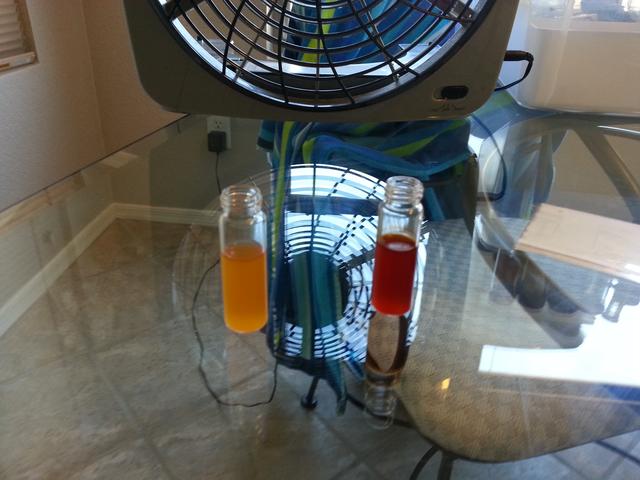
Two different types of peppers were used here (obviously). Although this is inside, I do not recommend it. A simple fan blowing over the vessels will be quite sufficient
Step 3: Concentrate the extracted oleoresin
In a very well-ventilated area (preferably outside), air-dry the acetone until the consistency is thick. This should be at least a 10X reduction in volume. Before the solution is too thick, transfer it to a container with a chemically compatible cap.
Again, note that acetone liquid and vapors are highly-flammable and inhalation of the vapor poses health hazards.
The image below shows the concentrated extract liquid. In this example, more liquid was added during evaporation so the total volume was reduced more than it appears. Still, I got impatient and you should wait longer until it is more concentrated (I'll do it again eventually and update).
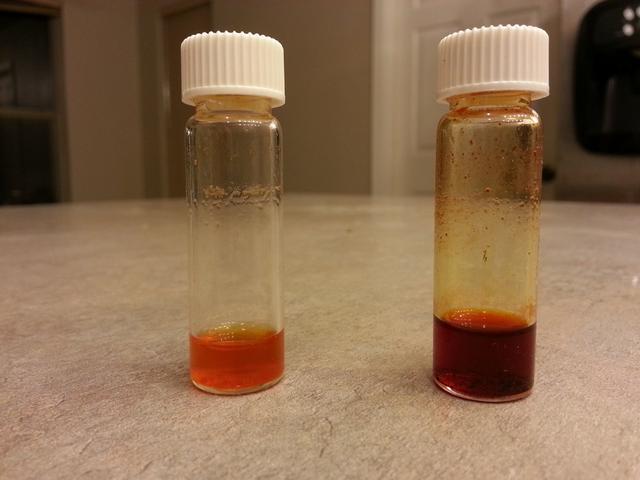
Step 4: Dilute and alkalize oleoresin
Dilute the concentrated acetone-oleoresin solution by 5X using the .025 N NaOH/KOH. In other words, add the .025 N hydroxide at 4 times the volume of acetone-oleoresin to get a final volume that is 5 times the original. Give it a good mix every few minutes for the first 10-20 min then put it aside at room temp for 18-24 hours.
The images below show the diluted alkalized solutions. Ideally, the dilution should be 5X which may not be apparent from the image.
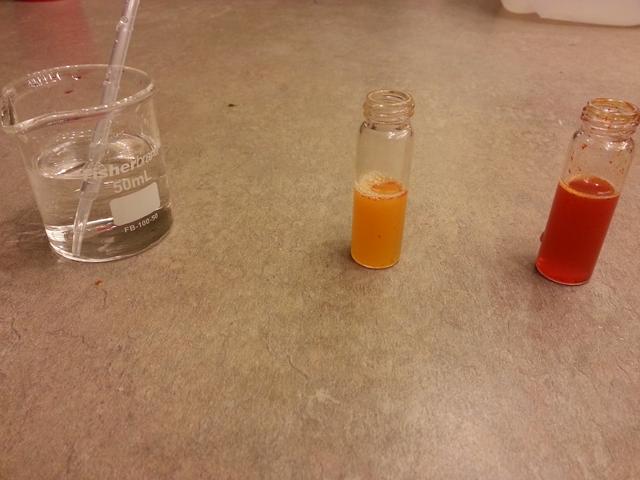
Step 5: Acidify and ROR-extract
Add .25 N HCl at 9% the volume of .025 N NaOH/KOH and give the solution a good shake. Using a glass pipette or dropper, add ROR at roughly 20% the total volume. Cap (with chemically compatible material) and shake this up every few minutes for 3-4X, then set it upright and wait for the phases to separate. After full separation, using glass pipette or dropper, transfer the ether phase to a new glass vial and cap it. Add more diethyl ether and repeat 2-3X, combining the ROR phase from each extraction in a single vial.
Here is the process depicted pictorially.
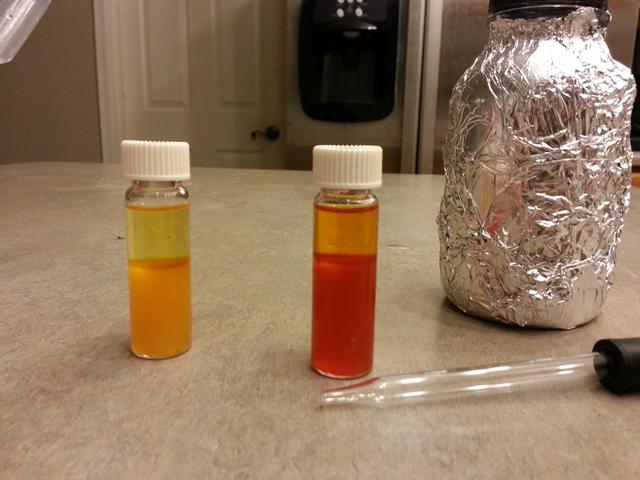
First, add the ether and cap the container. Remember to use glass transfer instruments, STAY AWAY FROM HEAT/FLAMES, and to cap your ether stock and protect it from light for best results.
In the above image, notice the separate layers (it has not been shaken yet). On top is the ether phase while the aqueous phase is below.
Shake the mixture and wait for the phases to separate as shown below. (Forgive the background peppers, I got bored waiting)

Notice the additional color that has been imparted to the ether - compare the above 2 images.
In the image below, the red peppers have undergone the second ether extraction (orange described in next step). Notice the decreasing color of both the aqueous and ether layers from the above image to the below and the next. Observe left ignore right for now.
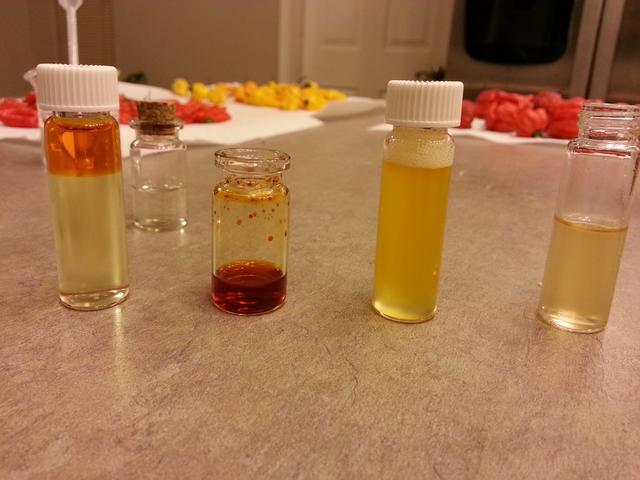
Observe left, ignore right for now.
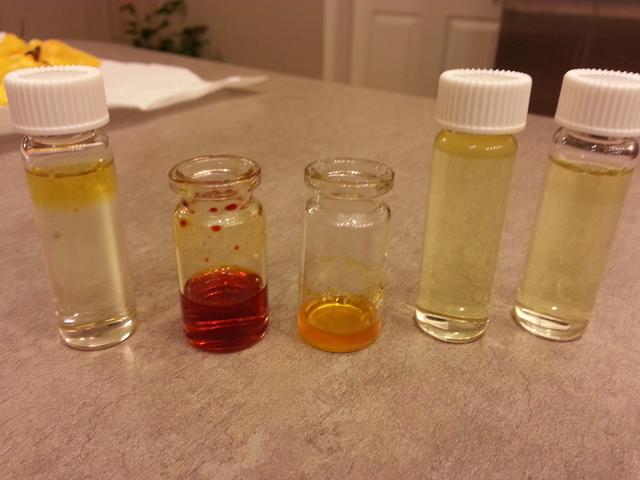
Observe left, ignore right for now.
Step 6: Distill ROR phase
NO HEAT!!! NO OPEN FLAMES! NOT EVEN A NEARBY TOASTER OR HOT SURFACE!!! THIS STUFF IS CRAZY FLAMMABLE AND DOES NOT REQUIRE FLAMES TO IGNITE. PLEASE DO NOT BE THE FIRST RECORDED PEPPER-RELATED DEATH!!
Evaporate the ether phase using a fan and outside or in an extremely well-ventilated area. You will see the oleoresin start to precipitate, as shown below, as the saturated ether is evaporated. This is likely hotter than any commercial oleoresin you have encountered for whatever type of pepper you chose.
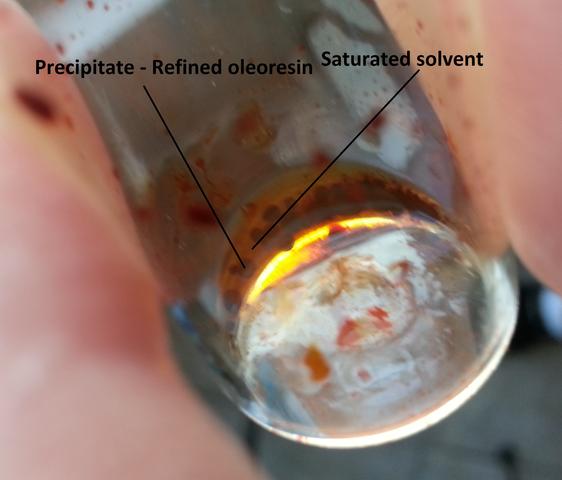
Continue the evaporation until you have a consistent thicker substance.
--------------------------
At this point, the product is still considered oleoresin, but if everything has been done properly and you used sufficiently hot peppers, it is unlikely that you will have encountered a hotter oleoresin before. See the image below; THIS is ‘true’ oleoresin i.e. without the adulterants that are present in so many others. After the ROR has been removed, it is safe to consume (you can do an ethanol ‘wash’ if you want to be sure but this will degrade the product slightly. Just dissolve in ethanol and evaporate). Take a toothpick and get a tiny amount then spread (touching wont transfer much at all due to hydrophobicity) it on your tongue.
---------------------
PART 2... to come
NEXT STEPS TO FOLLOW: Next, similar processes will be used to precipitate more and more components of the oleoresin as it nears pure capsaicin. These steps will require additional materials/equipment, so it will be in part 2 of the post since what can be obtained by the above procedure may be satisfactory for many people. The last step will require a reflux apparatus which can be constructed relatively easily, but it is still more investment. This stuff will be coming if people want it, so please let me know your thoughts on what has been described thus far and what you would like to see next.
Spread the knowledge! Debilitating heat for all!!
LAST UPDATE 2013/10/30 12:52
Hello All,
So as promised, here is the follow up to the “MacGyver Guide to Extracts” post. In the previous post, I covered a few methods that you could perform using things that you could probably find laying around the house, or purchase at the grocery store. This post will cover more advanced methods that will likely require purchases and more precise procedures. However, it will not require sophisticated laboratory equipment and can still be done at home. Accordingly, this an intermediate guide, and not yet the “Walter White Guide to Extracts” which I will post if and when I get around to performing and photo-documenting the full, laborious and time consuming process. Without laboratory equipment such as vacuum pumps, there will be more degradation of the capsaicinoid compounds, but if done properly, you should still be able to take down a grizzly bear with the final product.
This post’s target audience is the scientifically-curious general public, not trained chemists. It will involve some more sophisticated concepts than the MacGyver guide, but is not intended to be a text book and may contain some things that are not 100% accurate so as to avoid confusion - so again, no flames please. QUESTIONS ARE WELCOMED AND ENCOURAGED, as are suggestions if you find something “too simplified” or too far from absolute. MY GOAL WITH THESE POSTS IS TO SPREAD THE KNOWLEDGE AND ‘TRANSLATE’ FROM SCIENTIFIC MUMBO-JUMBO TO ENGLISH – PLEASE HELP ME TO DO THIS WITH QUESTIONS IF YOU HAVE THEM!!!
Section 1 - Introduction
Extraction basically boils down to one thing: dissolution. That is, dissolving the desired components of the pepper in an appropriate solvent. Refinement of extracts is essentially 'extracting from extracts' which involves separation of some of the dissolved components from others, and the basic principle is equally simple: solubility. The steps of the process described in what is to follow will each remove more non-capsaicinoid components from the extract. If one follows the entire process (both parts, the second of which is not yet posted), he or she will end up with mostly pure capsaicin. However, there are various points at which one may stop and still have an excellent product.
First off, forget about things that you may have heard such as soxhlet extraction – this is absolutely not necessary and actually introduces more impurities and may easily degrade the capsaicinoids. Also forget about using solvents like hexane that are mentioned frequently. Most are undesirable for extraction due to low capsaicinoid solubility (ref: http://lxsrv7.oru.edu/~alang/onsc/solubility/allsolvents.php?solute=capsaicin) and many chlorinated hydrocarbon solvents (e.g. chloroform) are teratogenic and/or mutagenic. They have their purposes for other processes but NOT oleoresin extraction. Many people pretend to know what they are talking about when it comes to these chemicals/processes/etc but you should be skeptical about most of this. Frankly, much of the discussion on the web is categorically incorrect.
Why should you believe me and ignore so many others? Well, in my opinion, you shouldn’t; you should always be skeptical and do your own research to confirm any claims made by anyone. I do not consider myself an expert in this particular field; unless you have done extensive research in the field and/or have your name listed first on related peer-reviewed journal publication(s), you are probably not an expert. That said, I am not merely a ‘hobby scientist’ – science is my career – and hopefully without sounding like too much of a c*ck, I do have ample qualifications.
1.1 History
Capsaicin was first extracted and isolated in pure form over 100 years ago and generally the work of Nelson (1910) is regarded as the first process to obtain a pure product. Since then, there have been many modifications and other techniques developed, but the vast majority still incorporate parts of Nelson’s procedure. I am not taking credit for discovering anything new here; my contribution is merely describing various parts of others’ work in ways that can be done at home.
1.2 Types of Extracts: Not just capsaicin
The term “extract” can mean a number of things and there are numerous products that are referred to as “extracts” with widely varying capsaicinoid content. Technically speaking, the cellulose from a pepper could be considered an extract. This post will, of course, focus on extracting the good (i.e. hot) stuff.
Oleoresin is the most commonly found and discussed hot pepper extract. Even this term is not specific in definition and a particular pepper’s oleoresins can be purified many times and still be considered oleoresin. In other words, oleoresins (even from the same pepper) are not all created equal and, like extracts, they can also vary quite a bit in capsaicinoid content. Oleoresin can be obtained very easily and these techniques are described all over the web (e.g. ethanol extraction). These extracts are often mistakenly referred to as capsaicin extracts, but are far from pure capsaicin. Here, we will discuss how to extract the most capsaicin possible with the oleoresin, and how to refine the extract products (i.e. remove the non-capsaicinoid contents). To give you an idea of what you’ll end up with if you go all the way to capsaicin crystallization, using ripened jalapenos you can expect a yield of less than 1% of the initial DRY pepper weight. Hotter peppers will give you more, but don’t expect a huge amount of the stuff.
1.3 Recommended Background
SECTION IN PROGRESS – MORE TO COME
Some basic chemistry background is recommended in order to increase quality of results, but not absolutely necessary. It is recommended that anyone who attempts the processes to follow be familiar with the following concepts:
- Molecular weight
- Molarity (concentration)
- Normality (acid/base concentrations)
- pH/pOH (acid/base strengths)
- Solubility
- Hydrolysis reactions including saponification (optional)
- Basic alkaloid properties (optional)
Section 2 - Materials
2.1 A word on safety (IMPORTANT)
If handled properly, there is little danger. Some of these chemicals are POTENTIALLY extremely hazardous, however, and if handled improperly one runs the risk of chemical burns, respiratory damage, heavy-metal poisoning, and even explosions to name a few. I'm not trying to be a fear monger; this isn't anthrax we're dealing with, and a bit of knowledge will keep you safe. Better safe than sorry... So, I implore you to familiarize yourselves with the following documents:
http://www.sciencela...?msdsId=9927164
http://www.sciencela...?msdsId=9924999
https://www.sciencel...?msdsId=9924285
http://www.sciencela...?msdsId=9927062
It is highly recommended that you download these documents for reference in case of accidental exposure.
As I’m sure you’re all aware, capsaicin itself can be quite nasty so wash your hands (especially before using the bathroom – learned this one the hard way lol).
2.2 Reagents
Remember, you can stop at various points, so you don't necessarily need all the reagents listed. The further you go, the more concentrated the capsaicin will be in your product. The reagents you will need, in the order in which you will need them, are as follows:
- Peppers!
- Distilled water
- Acetone -OR- Ethanol with dehydration procedure (see prep instructions)
- Magnesium sulfate (MgSO4) – or – Epsom salt (will require dehydration procedure)
- Sodium hydroxide (NaOH), or potassium hydroxide (KOH) – solid form preferable
- Hydrochloric acid (HCl)
- Diethyl ether, anhydrous (abbreviated ROR herein)
- Barium chloride (BaCl2) (Part II)
- Silver nitrate (AgNO3) (Part II)
- Glass vials with non-plastic (or protected plastic) caps – scintillation vials are great
- Glass pipettes or droppers
- Scale accurate to .05 g – make sure this is accuracy not resolution
- Volumetric glassware
- Glass and/or plastic containers for solutions you’ll be making
- Goggles (no exceptions)
- Respirator (recommended)
- Fire extinguisher
- All applicable safety equipment and antidotes are recommended
- Gloves, latex or nitrile are best
The following will need to be prepared to complete the coming procedures:
1. Anhydrous magnesium sulfate
Preparation of Anhydrous Magnesium Sulfate from Epsom Salts:
If you don't want to waste money buying already anhydrous MgSO4, you can make your own with a couple bucks worth of Epsom salt and an oven. Note that some of this will end up in your extract if you stop before ether steps (it is slightly soluble in ethanol), but as long as you don’t way-overdo it with the ethanol-to-pepper ratio it shouldn't be noticeable. You can Google “magnesium sulfate dehydration” and find plenty of info on this process. Comment or PM if you would like further info on this.
2. Anhydrous acetone
The acetone you buy is probably already low in water content, but it can't hurt to do this anyways. Add anhydrous magnesium sulfate (MgSO4) to the acetone at roughly 10% by volume (MgSO4 powder should take up 10% the total volume, acetone 90%). Give it a shake and set it aside for at least 30 minutes. Shake it a couple times during the 30 min if possible.
3. Anhydrous ethanol
The ethanol you have probably has at least 5% water content. This is because at 95% concentration, ethanol forms what is called an azeotrope with water which essentially means they evaporate together and distillation can't concentrate it any further. So, you should add a bit more MgSO4 - 20% by volume should be more than enough. You can't really over-do it here; nothing will happen other than making more of a sludgy mess at the bottom of the container. Shake it up and wait as described in the previous step. It's OK to have some MgSO4 dissolved in the ethanol.
4. 0.25 N HCl
37% hydrochloric acid (HCl) is as concentrated as it gets and is roughly 12 M. Dilute accordingly for a final concentration of 0.25 N.
5. 0.25 N NaOH or KOH
Both NaOH and KOH have a single OH so normality is again equal to molarity. The molecular weight of NaOH is roughly 40 g/mole. So, if you dissolve 40 g in one liter of water you will have 1 M or 1 N concentration NaOH solution. So for NaOH, dissolve 10 g per liter to make .25 N. Multiply the mass you dissolve by 1/purity - so if it is 90% pure, dissolve 10*(1/.9) g per liter. KOH is roughly 56 g/mole and exactly the same arithmetic applies.
6. 0.025 N NaOH or KOH
Dilute some of the solution you made in step 5 by 10X - 1 part step 5 solution to 9 parts distilled water.
Section 3 - Procedure
PART 1
ALL EXAMPLE IMAGES ARE OF A VERY SMALL SAMPLE AND ARE FOR ILLUSTRATION PURPOSES - YOU CAN DO MUCH MORE
Step 1: Prep the peppers
Choose a pepper variety (or mix) to use. The hotter they are, the hotter your extracts and larger your final yield will be (percentage wise). However, it may be more economically viable to use a larger amount of cheaper and milder peppers – you’ll have to decide.
First, dice the peppers up or blend them or whatever you want to get a fine pulp or small pieces (this is where you’ll want a respirator if you use hot peppers). The more surface area, the faster and better the first step of extraction will work.
Next, dry the pepper using just air if possible (oven will degrade product). You can place them in front of a fan for a couple days. Adding a bit off salt on top of the peppers or magnesium sulfate will speed the process but is not necessary. Make sure the pepper fragments are completely dry before proceeding.
Step 2: Extract oleoresin
Completely submerge the dried pepper pieces in anhydrous acetone and cap the container. Ideally, you should use 5-10 times the volume required to cover the peppers. The optimal conditions for extraction in acetone have been reported as 1 hr at 40C (lost the reference, sorry, and don’t know which kind of peppers), but several hours at room temperature will work just fine and will not require additional equipment. Shake the container occasionally. After ~3 hours (more is ok), dump the mixture into a beaker, cover with aluminum foil (or parafilm if you’ve got it) and let all particulate matter settle then transfer ONLY THE ACETONE LAYER to a new container. Note that many filters are not compatible with acetone. Using a glass pipette, or better yet a phase separation funnel (essentially a fancy glass beer bong), are probably the best ways but very slowly and carefully pouring the acetone into another container will work satisfactorily. In any case, try to get as little particulate matter as possible. If you have a way to filter the acetone (make sure it is chemically compatible), this is advantageous. Note that additional color does not necessarily mean more capsaicin, and it has been found that the capsaicinoids dissolve much more rapidly than some of the chlorophylls etc. so leaving it to sit for extended periods may be disadvantageous.
Note that acetone liquid and vapors are highly-flammable and inhalation of the vapor poses health hazards. Note also that many plastics will be dissolved by acetone (my wife once made the mistake of putting nail polish remover into a plastic party cup and a short time later found it dissolving the finish on the wood table).
The image below depicts the starting amount for this example, but you should follow the text instructions as the images do not depict them accurately.

Two different types of peppers were used here (obviously). Although this is inside, I do not recommend it. A simple fan blowing over the vessels will be quite sufficient
Step 3: Concentrate the extracted oleoresin
In a very well-ventilated area (preferably outside), air-dry the acetone until the consistency is thick. This should be at least a 10X reduction in volume. Before the solution is too thick, transfer it to a container with a chemically compatible cap.
Again, note that acetone liquid and vapors are highly-flammable and inhalation of the vapor poses health hazards.
The image below shows the concentrated extract liquid. In this example, more liquid was added during evaporation so the total volume was reduced more than it appears. Still, I got impatient and you should wait longer until it is more concentrated (I'll do it again eventually and update).

Step 4: Dilute and alkalize oleoresin
Dilute the concentrated acetone-oleoresin solution by 5X using the .025 N NaOH/KOH. In other words, add the .025 N hydroxide at 4 times the volume of acetone-oleoresin to get a final volume that is 5 times the original. Give it a good mix every few minutes for the first 10-20 min then put it aside at room temp for 18-24 hours.
The images below show the diluted alkalized solutions. Ideally, the dilution should be 5X which may not be apparent from the image.

Step 5: Acidify and ROR-extract
Add .25 N HCl at 9% the volume of .025 N NaOH/KOH and give the solution a good shake. Using a glass pipette or dropper, add ROR at roughly 20% the total volume. Cap (with chemically compatible material) and shake this up every few minutes for 3-4X, then set it upright and wait for the phases to separate. After full separation, using glass pipette or dropper, transfer the ether phase to a new glass vial and cap it. Add more diethyl ether and repeat 2-3X, combining the ROR phase from each extraction in a single vial.
Here is the process depicted pictorially.

First, add the ether and cap the container. Remember to use glass transfer instruments, STAY AWAY FROM HEAT/FLAMES, and to cap your ether stock and protect it from light for best results.
In the above image, notice the separate layers (it has not been shaken yet). On top is the ether phase while the aqueous phase is below.
Shake the mixture and wait for the phases to separate as shown below. (Forgive the background peppers, I got bored waiting)

Notice the additional color that has been imparted to the ether - compare the above 2 images.
In the image below, the red peppers have undergone the second ether extraction (orange described in next step). Notice the decreasing color of both the aqueous and ether layers from the above image to the below and the next. Observe left ignore right for now.

Observe left, ignore right for now.

Observe left, ignore right for now.
Step 6: Distill ROR phase
NO HEAT!!! NO OPEN FLAMES! NOT EVEN A NEARBY TOASTER OR HOT SURFACE!!! THIS STUFF IS CRAZY FLAMMABLE AND DOES NOT REQUIRE FLAMES TO IGNITE. PLEASE DO NOT BE THE FIRST RECORDED PEPPER-RELATED DEATH!!
Evaporate the ether phase using a fan and outside or in an extremely well-ventilated area. You will see the oleoresin start to precipitate, as shown below, as the saturated ether is evaporated. This is likely hotter than any commercial oleoresin you have encountered for whatever type of pepper you chose.

Continue the evaporation until you have a consistent thicker substance.
--------------------------
At this point, the product is still considered oleoresin, but if everything has been done properly and you used sufficiently hot peppers, it is unlikely that you will have encountered a hotter oleoresin before. See the image below; THIS is ‘true’ oleoresin i.e. without the adulterants that are present in so many others. After the ROR has been removed, it is safe to consume (you can do an ethanol ‘wash’ if you want to be sure but this will degrade the product slightly. Just dissolve in ethanol and evaporate). Take a toothpick and get a tiny amount then spread (touching wont transfer much at all due to hydrophobicity) it on your tongue.
---------------------
PART 2... to come
NEXT STEPS TO FOLLOW: Next, similar processes will be used to precipitate more and more components of the oleoresin as it nears pure capsaicin. These steps will require additional materials/equipment, so it will be in part 2 of the post since what can be obtained by the above procedure may be satisfactory for many people. The last step will require a reflux apparatus which can be constructed relatively easily, but it is still more investment. This stuff will be coming if people want it, so please let me know your thoughts on what has been described thus far and what you would like to see next.
Spread the knowledge! Debilitating heat for all!!

